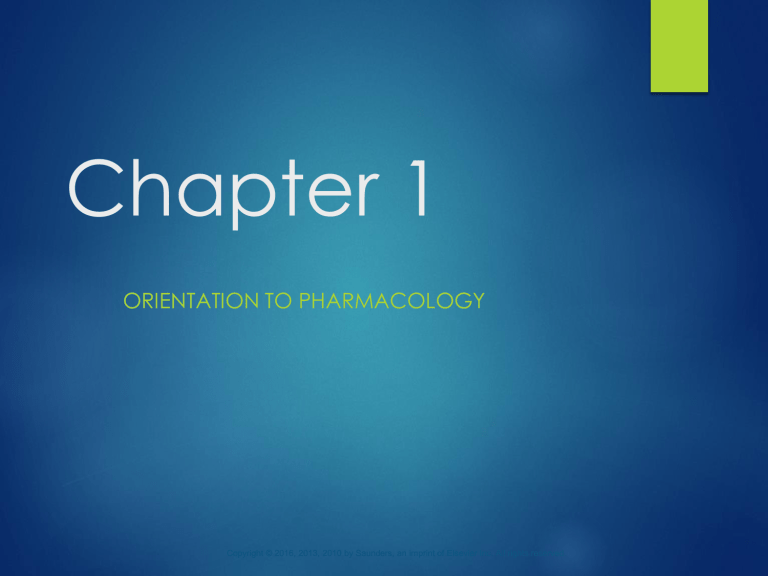
Chapter 1 ORIENTATION TO PHARMACOLOGY Copyright © 2016, 2013, 2010 by Saunders, an imprint of Elsevier Inc. All rights reserved. Pharmacology A 2 science that draws on information from multiple disciplines, including: Anatomy Physiology Psychology Chemistry Microbiology Copyright © 2016, 2013, 2010 by Saunders, an imprint of Elsevier Inc. All rights reserved. Four Basic Terms Drug Pharmacology Clinical pharmacology Therapeutics AKA -pharmacotherapeutics Copyright © 2016, 2013, 2010 by Saunders, an imprint of Elsevier Inc. All rights reserved. 3 Three Most Important Properties of an Ideal Drug 1. Effectiveness ! 2. Safety 3. Selectivity Side effects vs Adverse effects Copyright © 2016, 2013, 2010 by Saunders, an imprint of Elsevier Inc. All rights reserved. 4 Examples of Adverse Effects 5 Certain anticancer drugs can increase the risk for infection (for example, cyclophosphamide, methotrexate) Opioid analgesics at high doses can cause respiratory depression (for example, morphine, meperidine) Aspirin and other related drugs can cause severe gastric ulceration, perforation, and bleeding when they are taken for prolonged periods of time Copyright © 2016, 2013, 2010 by Saunders, an imprint of Elsevier Inc. All rights reserved. Additional Properties of an Ideal Drug Reversible action Predictability Ease of administration Freedom from drug interactions Low cost Chemical stability Simple generic name However, no drug is ideal… Copyright © 2016, 2013, 2010 by Saunders, an imprint of Elsevier Inc. All rights reserved. 6 Therapeutic Objective of Drug Therapy To provide maximum benefit with minimum harm Copyright © 2016, 2013, 2010 by Saunders, an imprint of Elsevier Inc. All rights reserved. 7 Factors That Determine the Intensity of Drug Responses Administration Pharmacokinetics Pharmacodynamics Sources of individual variation Copyright © 2016, 2013, 2010 by Saunders, an imprint of Elsevier Inc. All rights reserved. 8 9 Copyright © 2016, 2013, 2010 by Saunders, an imprint of Elsevier Inc. All rights reserved. Sources of Individual Variation Physiologic variables Age, gender, and weight Pathologic variables Diminished 10 function of kidneys and liver Genetic variables Can alter the metabolism of drugs and predispose the patient to unique interactions Drug interactions Copyright © 2016, 2013, 2010 by Saunders, an imprint of Elsevier Inc. All rights reserved.



